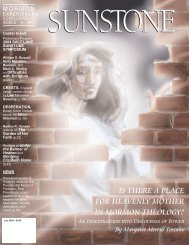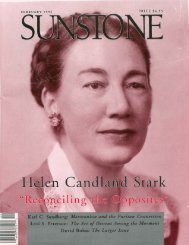00a_cover cmyk dark blue.qxp - Sunstone Magazine
00a_cover cmyk dark blue.qxp - Sunstone Magazine
00a_cover cmyk dark blue.qxp - Sunstone Magazine
You also want an ePaper? Increase the reach of your titles
YUMPU automatically turns print PDFs into web optimized ePapers that Google loves.
S U N S T O N E<br />
It’s this country that drives people<br />
crazy . . . It’s so pretty; it’s wild and<br />
clean and godly. But sometimes it<br />
makes me feel so lonesome I can’t<br />
stand it. It isn’t just the polygamists<br />
who go crazy down here.<br />
Everybody has more or less gone<br />
crazy. (303)<br />
Marianne’s comment carries a sting for<br />
Frank, since the prime examples of crazy are<br />
his own kin—and perhaps himself.<br />
The holy madness that runs in Frank’s<br />
family stems from the wild and godly landscape,<br />
but it paradoxically rejects the values<br />
of the earth itself. His mother, who teaches<br />
her sons that holiness means asceticism, expands<br />
the prohibitions of the Word of<br />
Wisdom to include all sensory pleasure, from<br />
sex to meat-eating—and flavorful food in<br />
general. Frank’s “natural man” loves the<br />
things that a being God made from soil might<br />
be expected to enjoy: good food, a hard day’s<br />
work on horseback, going to a dance in a<br />
Stetson hat, bringing home the first steer for<br />
his future ranch, and lying down next to a<br />
wife who has some flesh on her bones.<br />
Marianne loves the same pleasures, which is<br />
the strongest bond between them. But<br />
Frank’s idea of what God demands puts them<br />
on a regimen of unsalted beans and separate<br />
beds, leaving them both profoundly depressed.<br />
This Mormon version of an Opus<br />
Dei lifestyle leads, in time, to Frank taking a<br />
cheese-grater to his own flesh. As Marianne<br />
notes, he’s pulling her and himself down the<br />
path poor Jeremy has already walked, which<br />
ends in madness.<br />
Frank’s rescuer—a literal deus ex<br />
machina, who appears among the plumbing<br />
fixtures when Frank faces despair in a washroom—is<br />
the “Cowboy Jesus” who closes<br />
the novel. Jesus (who, startlingly, is a<br />
smoker) is more clearly a fellow Westerner<br />
than a fellow Mormon. He reconciles Frank<br />
to the innocent pleasures of the earth: work,<br />
play, and the love of a good woman. I found<br />
this ending a bit disappointing. I can’t really<br />
weigh in on theological questions. I am no<br />
Mormon but an outsider drawn to the<br />
strange loveliness of Mormonism and therefore<br />
open to the charge of fetishizing the exotic.<br />
But what interests me is “how God [is]<br />
feeling this morning up on the royal star of<br />
Kolob” (253), not the cowboy Jesus’ ecumenical,<br />
country-western reassurance. That<br />
message seems a retreat from the Mormon<br />
landscape’s magical threats and promises.<br />
The cowboy Jesus seems to forget that the<br />
land is not just clean and godly, but also<br />
wild.<br />
THAT’S how I thought about it,<br />
anyway, when I brought this beloved<br />
novel with me to the Andes after finishing<br />
my research in Spain. The Andean altiplano<br />
is an even larger version of the<br />
landscape that pushed Jamisons and polygamists<br />
into madness. A high plateau between<br />
mountain ranges <strong>cover</strong>s southern Peru and<br />
Bolivia, with Lake Titicaca at the center, the<br />
Andes’ answer to the Great Salt Lake. One afternoon<br />
I sat near a mine entrance at Potosí,<br />
an old silver-mining mountain from colonial<br />
times. I watched the miners cut the neck of a<br />
llama and splash the blood over the mine<br />
door to protect those who would enter the<br />
dangerous earth that year. I ate a little bit of<br />
that llama, half-cooked on an open fire. It reminded<br />
me of the polygamists of Johnson<br />
Valley who climb up the mountain to<br />
sacrifice a lamb at dawn, according to<br />
“the true Aaronic law” (306). “Criminy!”—<br />
as Marianne would have said.<br />
NOTE<br />
1. This statement is controversial, but the support<br />
for it seems convincing. For an overview of the<br />
controversy, see Brigham D. Madsen, “B.H. Roberts’<br />
Studies of the Book of Mormon,” Dialogue: A Journal<br />
of Mormon Thought 26, no. 3 (Fall 1993): 77–86.<br />
GHOST STORIES<br />
None were true so far<br />
as we knew: falling through<br />
ice or canoes capsized<br />
in rapids no one survives<br />
thirteen kids out of inner city<br />
huddled shoulder to shoulder<br />
while we two counselors<br />
boys ourselves voices<br />
still changing told not who<br />
vanished but how<br />
gathering firewood<br />
say the fire quietly alive<br />
these stories made up of<br />
nothing but other stories<br />
maybe ghosts mistold<br />
it could be any one of us<br />
—CHRISTIAN KNOELLER<br />
JEANETTE ATWOOD<br />
SEPTEMBER 2006 PAGE 63

















